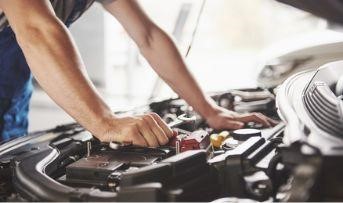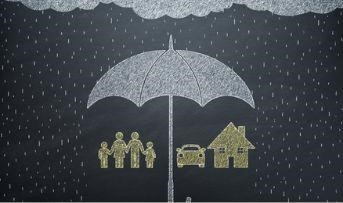General Insurance Blogs, Articles & Updates by - Magma HDI
Have us call you
- RENEW YOUR POLICY
- BUY NEW POLICY

Shedding light on Return to Invoice in motor insurance
Most people are familiar with motor insurance, its benefits, and its exclusions. It is an efficient financial instrument that supports us when our insured vehicle encounters an unfortunate incident. Motor insurance comes with many optional coverages that may be useful to you. Did you know about the Return to Invoice or RTI coverage? Choosing this coverage while you buy motor insurance online can be a great help. Let's learn more about RTI coverage, its benefits, and its functionality.
What is "Return to Invoice" in motor insurance?
Return to invoice is an optional coverage for your car insurance. It lets you get money equal to the car's original value, also called the invoice value. This coverage is not required by law, so you can buy motor insurance online and include RTI coverage as an add-on. It is an application you use when your car faces total loss, such as if someone steals it or it gets fully damaged by fire or a natural calamity.
How does it work?
In normal car insurance coverage without an RTI add-on, you can get the maximum claim amount as your car's "insured declared value" (IDV). IDV is always less than the invoice value of the car.
However, with car insurance having RTI coverage, you can get the maximum amount of claim on the invoice value of your car. In simple words, when you have RTI coverage in your car insurance, you can get the road value of your car when it is stolen.
How is it calculated?
You can easily determine the amount of insurance that comes with RTI by looking at the car's total price when you buy it. The return to invoice includes the total car price, such as road tax paid, ex-showroom price, and registration cost.
What is covered in Return to Invoice?
If your car gets stolen or damaged beyond repair, you can raise a claim against the RTI. Let's look at the different circumstances when this coverage can benefit you:
● When you don't have secured parking
● Living in an area where car thefts are common
● Living in an area prone to natural calamities such as floods, landslides, and more
What does not apply in the Return to Invoice?
Sometimes, the RTI cover may not work, and you can't claim the insured amount. Here are some situations when this cover is not applicable, including:
● Damage to your car when someone else is driving
● You can't avail RTI add-on if your car is older than 3 years from the buying time
● You can't avail of the RTI cover for minor dents and grazing on the car body
● You must submit a copy of the FIR to process the return-to-invoice claim
Benefits of Return to Invoice in motor insurance.
Some benefits of RTI in car insurance include:
● It increases the scope of your car insurance coverage
● It is beneficial when you live in an area where car thefts are common
● It is available for new cars. Hence, you can give your new car more care with this cover
● It is available with a comprehensive car insurance policy
Once you understand everything about the Return to Invoice, consider adding this optional cover. RTI can help you when your car is damaged beyond repair. If you live or park your car in a place where theft, natural calamity, or fire is common, you should add RTI to your policy when you buy motor insurance online.
Click HERE to buy motor insurance online.
Disclaimer: The information provided above is for illustrative purposes only. To get more details, please refer to policy wordings and prospectus before purchasing a policy.

Understanding how a cashless garage facility can be helpful
A cashless garage facility is one in which an insurance company has a tie-up with a garage. Whenever you meet with an accident or file an insurance claim for repairs, you will not have to settle the bill in cash at these garages. The insurance company will directly pay the bill. However, you have to bear some nominal charges for processing the claim. Also, some compulsory deductibles exist as per the insurance policy’s terms and conditions.
Not all garages will have a tie-up with your respective insurance company. The list of network garages is easily available with your insurance company. You need to verify it with your insurance provider and search for the nearest garage that will provide you with a cashless facility. Let us see how a cashless garage facility can be helpful to us.
1. Hassle-free claim settlement:
Insurance companies are directly connected to the network garages. Hence, you do not need to visit multiple garages to complete the repair work. You can directly go to the network garage after informing the insurance company, provide the required documents, and that’s it! The garage will take it over, and the insurance company will settle the bill. The entire claim settlement process becomes hassle-free.
2. Prompt service:
As mentioned above, not all garages are covered in the cashless network list of the insurance company. Hence, listed garages provide prompt and good quality repairs and renewal services to maintain harmonious relations with the insurance company. This can be helpful to you, and you’ll get quick service and timely delivery of your vehicle.
3. No cash payout:
This is one of the most important benefits of a cashless garage facility. In the non-listed garage, you have to settle the entire bill in cash at the time of delivery of the car. Accidents do not come informed. Hence, such sudden bills can put you under a financial burden. The repair costs of modern-day cars are hefty and can cost several thousands of rupees in one go.
A cashless garage facility will release this financial burden from you, and you’ll not have to pay any repair costs from your pocket. Minor documentation and deductibles charges can be easily met. This facility makes the claim settlement process swift, and you do not have to worry about footing the repair bill.
4. Transparent billing and quality service:
The insurance company and its surveyors are in constant touch with the network garage. They provide a big chunk of work to the garage regularly. Hence, the network garages abstain from committing any fraud, using sub-standard components and parts, or engaging in over-billing while repairing cars. Hence, we are assured of fair and transparent billing and top-notch service.
A cashless garage facility is a blessing for all vehicle owners. It makes the claim settlement process convenient, hassle-free, and fast. Also, it relieves us from paying sudden and heavy repairs and renewal charges when our car meets with an accident. We get quality work at reasonable prices.
But first, you need to have a valid and functional motor insurance policy for your vehicle to enjoy a cashless garage facility for it. Always renew your insurance policy on time and never let it expire because accidents do not announce before occurring. Opt for online motor insurance renewal, which makes the renewal process effortless. You can do it from the comfort of your office or home, at any time of day or night. Also, you are saved from the hassle of meeting with the insurance agent or going to the insurance office for renewal. Go the modern way; choose online motor insurance renewal.
Click HERE for hassle-free online motor insurance renewal.
Disclaimer: The information provided above is for illustrative purposes only. To get more details, please refer to policy wordings and prospectus before purchasing a policy.

Did you know about the knock-for-knock agreement in motor insurance
In India, awareness about motor insurance has grown significantly in the last few years. The number of insurance policyholders is slowly but steadily increasing. The increasing means of living and demand for luxury goods to improve convenience are anticipated to keep driving the market for motor insurance. Comprehensive motor insurance consisting of own damages and third-party covers is expected to grow more in the coming future.
Third-party liability insurance is mandatory to protect the driver against legal and accidental liability, financial loss or property damage, and medical expenses he may face after an accident. Despite its advantages, settling claims is a lengthy and costly procedure. The knock-for-knock agreement is a recently introduced aspect of motor insurance to simplify the process and increase the policyholder base and satisfaction.
This blog discusses all you need to know about the knock-for-knock agreement.
The issue before the knock-for-knock agreement:
When an accident happens, the persons involved can contact their insurance companies to compensate the other party for damages. However, this is a lengthy procedure that may sometimes take months to settle with unfavourable conditions. It is also still being determined whether or not the insurer will accept the claim.
In the background of such uncertainties, the affected party has no choice but to file a suit in court, which takes additional time and cost. The knock-for-knock agreement aims to eliminate this waiting period by providing an alternate solution to settle the claim among the parties without the court's involvement.
An alternative approach using a knock-for-knock agreement:
The knock-for-knock agreement is signed by two or more motor insurance companies insuring two or more parties involved in a motor accident. Since these companies are aware of the tedious claim settlement process, they use this alternative agreement and promise to bear the expenses for repairs or damages to their client instead of claiming the amount from the other party. Introduced in 2001 by the General Insurance Council, a motor insurance company doesn't need to sign such an agreement to make the claim process quick.
Advantages of knock-for-knock agreement:
While the concept is simple to understand, here is the summary of the benefits of signing a knock-for-knock agreement:
● Speedy settlement of claims
● Eliminates the need for the involvement of law
● Reduces the expenses required to be borne in case of proving the liability of the third party to derive a settlement from his insurer
Conditions for knock-for-knock agreement:
Three primary conditions are applicable for claims that are admissible under a knock-for-knock agreement.
1. Accidents must occur within geographical boundaries:
The insurance company decides such boundaries before the lodging of the claim. Generally, the limit is considered to be the defined geographical boundaries of India. It is implied that any accident outside the border cannot be admitted as a claim under a knock-for-knock agreement.
2. The claim must be filed as own damages:
Under the agreement, each motor insurance company agrees to compensate its client instead of demanding compensation from the other party. This claim can no longer be filed as third-party damages and is processed as "own damage". Therefore, you must purchase your "own damages" cover, without which you cannot complete this procedure.
3. Limit on the claim amount:
The admissible claim cannot exceed the insured declared value (IDV) previously mentioned in the policy.
The knock-for-knock agreement is a lesser-known aspect of motor insurance that makes claim settlements speedy and inexpensive. It saves the resources of a motor insurance company that agrees to such a contract. Explore this aspect to know more about its seamless benefits before buying motor insurance in India.
Click HERE to buy reliable motor insurance in India.
Disclaimer: The information provided above is for illustrative purposes only. To get more details, please refer to policy wordings and prospectus before purchasing a policy.

Know more about the anti-locking braking system in detail
A critical safety element that is now standard in all modern vehicles is the anti-lock braking system, or ABS. The ABS is frequently marketed as an efficient breaking mechanism that significantly reduces accident risk by facilitating a good grip over the vehicle. We go over everything you need to know about ABS, including its advantages, how it works, and the several kinds you can find in modern vehicles.
What exactly is "anti-lock braking"?
The name of the technology suggests that when you apply the brakes, ABS keeps the wheels from locking. It shortens the distance you need to stop and lets you move or "steer" the car while the brakes are still on. This way, you can avoid collisions from sudden braking and crash into fellow vehicles or objects.
What is the purpose of ABS?
Irrespective of the car's speed, when you press the brake pedal (without ABS), the wheels lock up because the brake pads make tight contact with the wheel discs and stop the wheels from turning.
The car skids because of its momentum when the wheels stop rotating. As a result, the driver has no control over the wheels. Most frequently, this can result in severe accidents.
What are the main components of ABS?
Speed sensors, valves, a pump, and an ECU comprise most ABS parts.
Speed sensors:
These sensors are important to keep track of the wheels' speed.
Valves:
In the brake line, some valves regulate the pressure on the brakes.
Pumps:
When brakes are used, hydraulic fluid-filled pumps pressure the brake callipers or drums.
Electronic Control Unit (ECU):
In response to the signals from the speed sensors, the ECU acts as the command centre of all the processing.
How is ABS used?
When you use the brakes on a car with ABS, the speed sensors track how slowly the wheels turn. Brakes deliver a signal to the electric control unit when they are about to stop rotating. Using valves and pumps, the ECU removes some of the brake pads from the wheels, allowing them to continue spinning. When you apply heavy brakes, ABS enables the wheels to continue turning, giving you control over the car.
Without ABS, when you hit the brakes, the wheels would stop or lock up immediately, causing the car to slide. In this situation, the vehicle would skid and travel a fair distance. It would be challenging to turn your vehicle because the wheels were locked. ABS helps you slow down efficiently, deploy uniform braking, and quickly control your car and avoid it from spinning.
ABS benefits:
● Uneven tyre wear is avoided because the wheels don't lock up when the automobile is stopped.
● The Traction Control System (TCS) and ABS share specific fundamental architectures, which facilitate TCS installation on vehicles in manufacturing facilities.
● You may steer the automobile around obstacles when braking hard, which can reduce brake pad and brake disc wear.
● Minimises the risk of severe accidents due to sudden braking and enhances the car's stability post-braking.
When the brakes are applied hard at high speeds, ABS keeps the wheels from locking up, which makes it much less likely that a deadly accident will happen. The effectiveness of the anti-lock braking system has been demonstrated everywhere. Anti-lock brake systems are now so critical to safety that the Indian government has made them a requirement.
Safety is paramount, and braking is a crucial part of vehicle safety. It's also a good idea to get online motor insurance to upgrade the security of the vehicle and the owner. Motor insurance covers car owners' liabilities and protects them from damage to their cars and any legal obligations they may face. Browse through different options and opt for online motor insurance with the best premium and benefits that suit your needs.
Click HERE to buy online motor insurance.
Disclaimer: The information provided above is for illustrative purposes only. To get more details, please refer to policy wordings and prospectus before purchasing a policy.

These are a few common drainage problems harmful to your house
Most households should foresee drainage issues. We can only hope that the drains in our homes are in good condition because they are out of our sight. But several early indicators alert us to a drainage issue. If left unattended, these drainage concerns put people at risk and give rise to crises like safety, health, and financial problems when dealing with poor drainage conditions.
Seven typical drainage issues have been discovered to guarantee a flawless drainage system by sorting these issues:
1. Even with safety precautions, a clog in the drain system is unavoidable, and people flush many things down into the drain. Although it might begin as a slow-moving drain, it could eventually worsen and end up blocked. It is crucial to try an at-home fix for a blockage as soon as it gets noticed.
2. The installation, regular cleaning, and maintenance of gutters and downspouts are essential for the exteriors of dwellings. Numerous issues have arisen when several people take responsibility for their work independently. Both insufficient pipe installation and a lack of plumbing experience are the leading causes. If pipes aren't put in the right way, they can cause plumbing issues, broken tubes, and other property damage, along with the improper passage of sewage.
3. Drain pipes are subjected to a lot of wear and tear, resulting in fractures or cracks that cause the pipes to have open joints. Water leaks from these cracks could result in serious issues in the neighbourhood and even structural damage. Another indication of leaks and an excess of moisture is the development of mould. Pest infestations that enter through pipeline cracks are another issue about pipe breaking and leakage. Fortunately, one can easily fix these problems with prompt diagnosis.
4. With the right slope, water will flow away from the house. It has a big effect on the slope of the land so that the drainage moves away from buildings, especially in places that need to be paved, like parking lots and driveways. Sometimes, the builder might get this wrong and let water seep in or get stuck in the structure, damaging the walls.
5. The growth of plants can be dangerous to plumbing. In the trenches built around pipes and drains, tree roots can obstruct or destroy pipework as they develop and spread. They can enter the drainage system through openings, mainly already-damaged joints. They usually leave a mess of odours and have significant health risks.
6. Heavy rain or storms and the debris they leave behind can cause clogs, floods, or overflows in the drainage system if not appropriately covered.
7. Flooding can put pressure on pipes and can damage the ground. An inadequate drainage system or pipes is another sign of outdoor flooding.
8. Assume your house is next door to your neighbour's. Even if you take all the proper steps, there is still a chance that water from your neighbours' properties will cause damage to your property. It can occur because of a flood on their land or simply because your property is lower than theirs. To prevent water runoff from the neighbours, you must take the appropriate actions and ask for effective waterproofing of the floor.
These problems show how important it is to keep up with drainage system maintenance to avoid extreme issues. Even though most drainage problems aren't evident at first glance, the above points will help you figure out what's wrong and how to fix it.
Conduct periodic inspections of your house's drainage system and look for damages in the pipes, sinks, or ducts. Immediately call the experts to fix it before the issue becomes severe. Ensure regular cleaning of the drains to avoid clogging and unwanted growth of plants. To deal with other problems related to the well-being of your home, like protection from damages to belongings due to natural calamities and other issues like riots, invest in a reliable home insurance India policy. This will provide you with optimum coverage for your home financial support by compensating for the damages caused.
Click HERE to buy home insurance India.
Disclaimer: The information provided above is for illustrative purposes only. To get more details, please refer to policy wordings and prospectus before purchasing a policy.

Here are a few effective winter travel tips for enjoying a memorable trip
Who does not love to travel in the winter season? The chilly weather with snow-clad mountains or the cool climate on the beaches and plains can be delightful and welcoming. Taking advantage of the pleasant climate and an ideal season to travel, numerous tourists plan family holidays and group tours to explore the best winter destinations in India. But the idea of winter travel reminds us of the arduous task of carrying thick, heavy, woollen clothing.
Are you planning a family trip or a solo adventure this winter? Here are a few effective winter travel tips for enjoying a memorable trip.
1. Plan in advance:
Winter travel in December and January coincides with Christmas and New Year vacations in schools and holidays in offices. Hence, there is usually a lot of crowd at popular vacation spots and heavy bookings on flights, trains, and hotels.
Hence, you should always plan your winter trip well in advance. Book your travel tickets and accommodations as early as possible so that you don’t have to cancel your trip at the last moment due to the unavailability of travel tickets or rooms in good hotels.
Even if you can get flight tickets and good accommodation at the last moment, you will have to pay exorbitant rates. So why not plan in advance, save money and make your trip memorable?
2. Check your flight and train departure:
Always check the timings of your flight or train departure in the winter season before leaving home. They are usually delayed and are sometimes even cancelled due to heavy fog and low visibility. Keep an alternate route or service in mind in case of any cancellations. This will ensure that your travel plan gets successful.
3. Travel light:
You will wonder how we can travel light with bulky woollen clothes, especially if we are visiting some cold place or a hill station. It is possible by following some simple tips. Wear your most bulky jacket, sweater, shrug, or scarf on the day you have to travel. This will mean you will not have to pack them inside your bags. Also, wear your heavy boots and pack your lighter shoes or slip-on in your bag.
Do not pack multiple t-shirts, tops, or jeans with you. Repeat them. What you wear on the top is only visible in winter. Keep changing your jacket, shrug, or coat, and no one will know you are repeating your dresses! Also, buy woollen clothes of superior quality so that you don’t need multiple layers of clothing to keep you warm. Carry thermal innerwear of good quality as they are light and warm.
4. Rent travel gear:
You don’t need to carry your travel gear everywhere you travel in winter. For example, if you want to ski in the snow, you can rent all the essential gear, including snow boots and overcoats, from the resort you are staying in.
5. Medication:
The cold season brings many ailments, such as flu or fever, nasal congestion, cough, etc. Always carry appropriate medication, especially when travelling with kids and the elderly. Also, use small cases for carrying your cold cream and moisturiser so they only take up a little space.
Make your winter trip special and memorable by following the above travel ideas. Another important tip is to go for your true companion that will never leave your side, i.e., travel insurance. Travel insurance will protect you against trip cancellations, lost baggage, damage to your luggage, etc. You can take an annual plan to cover all your trips or insure only a particular trip.
Insurance will also offer coverage in case of any medical emergency and assistance arising during your trip. Make your life secure and tension-free by choosing a wide variety of general insurance policies. Moreover, buy online general insurance from the ease of your home with a few clicks, additional benefits, and the best premium rates. We wish you a happy winter!
Click HERE to buy online general insurance before planning your winter travel trip.
Disclaimer: The information provided above is for illustrative purposes only. To get more details, please refer to policy wordings and prospectus before purchasing a policy.

Smart tips for washing home glass windows with sparkling shine
Have you ever tried running your hand over your house's glass window panes? The amount of dust you will come across is worrisome. We all are familiar with the saying "cleanliness is next to godliness," but at this point, it is not just about keeping your house clean. It is also about your and your family's health. The dust that settles on furniture, doors, and windows surfaces enters your body when you inhale while just being around your house and going about your everyday chores.
Many times, we rush to the doctor with a common cold or some health issue which is related to the hygiene problems arising from the dust and dirt which have made their way into our home, costing us several trips to the emergency room, medicine dosages, or having a troubled sleep at night.
But how can you combat this problem? Don't worry. This blog will discuss smart tips for washing home glass windows with sparkling shine, which would help you eliminate the tiniest speck of dust, leaving the glass panels squeaky clean!
1. Notice the frame:
If you closely examine a window, you will be shocked by the amount of dust, spider webs, etc., settled on the frame of the glass. The first step to cleaning your windows would be to clean the frame so that the dust particles do not float in the air and find their way to any other surface. You can use a microfibre towel to clean the dust and a sparkling shine solution to wipe off the frame after dusting.
2. How about a mop:
The windows can be large and high, which might not be accessible to clean using a small microfibre towel. A mop with a stretchable handle is the best idea in this scenario. You can dip the mop in a solution, wring it and then wipe the glass windows by stretching the handle to the required length. Ensure that the mop reaches all the corners of the windows, thus giving them the sparkling shine!
3. A small wiper is an intelligent option:
Doubling up on cleaning supplies has never gone to waste. Apart from using a microfibre towel and a mop, you can also use a small wiper which would help you wipe off the cleaning liquid so that it doesn't leave a stain on the window. Keeping a wiper will help you clean the window's exterior glass panel, thus eliminating pollen or bird waste, etc.
4. Rain can be difficult for the windows:
It is advised to clean the windows from the inside and the outside three to four times a year. The most favourable time to clean your windows is during spring and autumn. Cleaning your windows during these seasons helps eliminate any complicated to-clean mineral deposits that might have been set due to the rains.
5. Cleaning directions are a huge bonus:
Spraying some cleaning liquid and using a microfibre towel to wipe the windows can have magnified effects if you clean the window in a circular motion and jazz it up by swiping horizontally and vertically to avoid setting off any liquid stains or dirt.
Other tips include using tongs when cleaning window panes and blinds, using a lint roller on the window screens to remove the lint that might have found its way, cleaning/vacuuming the curtains, etc.
These were a few smart tips for washing home glass windows with sparkling shine. Keeping your house clean and hygienic is very important. Home is not just a place to live; it is an emotion. It houses millions of memories and fosters relationships, so you must get home insurance to protect this sacred space against any unforeseeable mishaps and situations. You can look for the benefits of the various home insurance options which are available in the market and purchase the one which suits your needs.
Click HERE to learn more about buying home insurance.
Disclaimer: The information provided above is for illustrative purposes only. To get more details, please refer to policy wordings and prospectus before purchasing a policy.

List of ancient temples in India that you must visit once in your lifetime
Out of 195 countries, setting oneself apart from others is difficult. Most countries are either known for their rich resource endowment or their progress and economic significance. Over the years, India has continuously made optimal use of its resources to cultivate its financial position amongst other leading developing and developed countries. However, one thing that makes India genuinely unique is its rich cultural identity.
India is a land of deep-rooted culture and traditions. Ancient temples and practices are proof of the long legacy of the old civilizations that formed the fundamentals of society. There are over two million temples in India, proving the significance of heritage and spiritualism in the country. Of this enormous number, many temples have existed since the rule of the ancient kingdoms and are proof of the vibrant traditions and beliefs of Indians.
The easiest way to experience the diverse culture of the expansive land is by immersing in the historical archives engraved on the temple walls and sculptures. Before you plan your trip to explore these temples, we recommend contacting a general insurance company to purchase a comprehensive cover to compensate for any damages during travel. After checking that off, here is a list of ancient temples you must visit!
1. Mundeshwari Devi Temple:
Located in Bihar, it is said to be one of the oldest temples in the country, open to the public. The Archaeological Survey of India dates the temple back to 108 AD after consideration of its design and architecture. The temple is a shrine for Lord Shiva and Goddess Durga and is popularly known for its distinct octagonal design.
2. Somnath Temple:
Located in Gujarat, the Somnath Temple worships Lord Shiva. It is one among the 12 Jyotirlingas and holds great significance to the devotees of Shiva. The legend behind the temple also involves the Moon God. The temple initially held massive troves of treasures, which Mahmud of Ghazni raided during his attacks. Despite being destroyed, the temple has been restored and provides a peaceful environment to bask in its cultural significance.
3. Sree Padmanabhaswamy temple:
The gold-plated temple in Kerala is dedicated to Lord Padmanabha. Also known as the richest temple in India, the temple is thought to have existed for over 5000 years. The temple's wealth is estimated to be around 1 Lakh Crore Rupees, excluding a closed vault that cannot be opened until the chanting of the Garuda Mantra, an unknown chant.
4. Konark Temple:
The temple, built in the 13th century, is a UNESCO World Heritage site in Orissa. Dedicated to the Sun God, its architecture sets it apart from other temples. It is designed based on geometric ideals, making it truly unique. The main temple had a suspended sun idol built using granite and magnets.
5. Dilwara Temple:
Dilwara Temple is an important Jain pilgrimage in Mount Abu built between the 11th and 13th centuries with intricate engravings. The exterior does not give insight into the grandeur of the exquisite marble carvings inside. The hilly terrain outside makes one appreciate the entire process of building the temple in an age without the convenience of transport vehicles.
6. Amarnath Cave Temple:
Situated in Jammu and Kashmir at a height of 3900 metres, visiting this shrine is an experience like no other. It is a naturally formed cave with a lingam of ice resembling Shiva's idol. Reaching the temple is challenging and requires significant effort and dedication.
While it is recommended to visit such divine places to uncover and understand the traditions and Indian heritage, it is also essential to pay heed to one's safety during the travel. A general insurance company provides excellent travel protection that one must consider before planning a trip.
Click HERE to buy travel insurance from the best general insurance company.
Disclaimer: The information provided above is for illustrative purposes only. To get more details, please refer to policy wordings and prospectus before purchasing a policy.

Here are the best blue water beaches in India which should be on your wishlist
Who does not enjoy travelling? Being able to visit and explore new places, try local cuisine, click pictures, and enjoy the native culture of a place is the dream of every traveller. Travelling fills the heart and mind with a sense of euphoria. It boosts your happy hormones and uplifts your spirits. Hence, everyone must take at least one vacation every year.
What if you're a beach person looking for your next blue water beach holiday in India? This article is just for you. We recommend 05 top beach holidays where you can enjoy quality time in blue waters and golden sands.
However, no matter where you travel to, you should always have general insurance to back you up. You can check the general insurance online quote in advance and purchase insurance that provides comprehensive coverage for your luggage and ensures a safe trip.
Here's a list of the best blue water beaches in India.
1. Marari Beach, Kerala:
If you're a fan of Kerala, you should visit this beach. Located near Kochi, this beach is close to the Mararikulam village of Kerala. The waters are apparent here. It is also peaceful and full of lush green vegetation around the village. It is also rated among the top five hammock beaches in India. You can spend some quality time here with your loved ones.
2. Butterfly Beach, Goa:
Present in South Goa, you can reach this beach easily by taking a ferry ride from Agonda beach. It is one of Goa's hidden gems, unexplored by most travellers. Not many people are aware of the magnificence of this beach. It is picturesque and beautiful in every possible way. It is a haven for nature lovers. Many butterflies hover over the beach, making it all the more enticing.
3. Radhanagar Beach, Andaman and Nicobar Islands:
It is one of the most picturesque beaches on Andaman and Nicobar’s Havelock Island. It has clear blue waters and white sands to its credit. A line of coconut trees surrounds the coastline, making it all the more aesthetic. The sunsets here are a sight to behold. You also have the chance to participate in various water sports when you are here at the beach.
4. Varkala Beach, Kerala:
Also known as Papanasam Beach, Varkala beach is one of the most breathtaking beaches in Kerala. You will catch a stunning view of the Arabian Sea from the cliffs present at the beach. You can either sunbathe on the golden sands or stroll by the coast. This beach is serene yet beautiful. You can also go swimming in the waters and rejuvenate yourself.
5. Bangaram Beach, Lakshadweep:
With its jaw-dropping blue waters and white sands, this beach is a cheerful retreat to enjoy with close ones. It is secluded from the hustle and bustle of city life. The beach has brown rocks on all sides. It makes the beach all the more attractive. The beach also has unique bioluminescence at night. The blue waters glow and look starry.
Make these top beaches a part of your travel bucket list and plan a dreamy holiday to savour these destinations' mystic charm. Regardless of the places you want to travel to, always have general insurance to keep your travel covered. An ideal insurance policy will cover your expenses if you incur any damages while travelling or if your luggage is damaged or stolen. You should also check the general insurance online quote before you apply for any policy. Research the best options and invest in a plan that best suits your needs. Better be safe than sorry!
Click HERE to get a general insurance online quote.
Disclaimer: The information provided above is for illustrative purposes only. To get more details, please refer to policy wordings and prospectus before purchasing a policy.

Enlisting the simple yet effective soundproofing solution for your room
We all want to live and work in a peaceful environment that motivates us to always give our best. Silence boosts productivity and makes the surroundings blissful. Silence is required for various activities throughout the day. Whether studying, working, or even sleeping, loud noise can disrupt your peace and well-being. High levels of sound have many ill effects on an individual's physical and mental health.
Significant decibels of sound not only lead to noise pollution but also contribute to an unbalanced lifestyle. It can increase blood pressure and heartbeat. It is also highly harmful to kids and older adults. Increased exposure to noise can damage the eardrums in the long run. It also increases anxiety, frustration, and irritation and can even trigger migraines and anxiety attacks.
The simple way to tackle this problem lies in soundproofing. It is a great boon to humanity and helps in preventing unnecessary sounds. Everything can be blocked by using soundproofing at home, from construction noises to vehicle horns.
Before making any changes to your house, purchasing the best house insurance India is recommended to safeguard your home in emergencies.
Without further ado, let's have a look at the best tips and tricks for soundproofing quickly at home.
1. Make use of soft materials or fabrics:
It is a known fact that sound travels via waves. This means that hard materials like metals amplify the sound. The more iron, tin, or copper you have around, the more complex sound will travel through them. On the other hand, soft materials like linens, cotton, and silk absorb sounds. The more soft fabric you have in a room, the better. Your curtains, carpets, blankets, and rugs can contribute a great deal to absorbing sound. You can also invest in soundproof curtains.
2. Use acoustic frames:
It is one of the latest things available for absorbing sounds. They are wooden frames with foam intact in them. They are highly efficient in absorbing sounds. They can be hung on the walls for soundproofing. This also prevents the noise of adjacent rooms from entering the desired room. It is excellent for people who live in apartments or condos. Acoustic frames are available in various shapes and sizes as well.
3. Consider adding layers:
If your building is still in development or if you have access to renovations, consider adding a layer of drywall. This wall will separate your room from the outside world. It will also cut off all external noises and prevent them from reaching your room. The stronger the wall, the better. It is advisable to get it done with the help of professionals while building a new room.
4. Notice the doors:
The doors play an integral role in determining the amount of sound that enters the room. For starters, keep it closed at all times. You can consider adding weather stripping around the door knob or handle. This will prevent any unnecessary noise from entering or leaving the room. You can also make use of a soundproof blanket. It can be put at the back of your door and removed when not needed.
5. Pay attention to the floors:
Floors can also help in soundproofing. You can put carpets on the floor to absorb the noise from outside. If you want a more effective solution, you should use foam flooring. It can be easily added over the flooring present and does not require much effort for installation.
These are some great ways to prevent noise from entering your house. Implement these and reward yourself with a peaceful and soundproof environment. In addition, protect your home with the best house insurance India, as it helps you deal with financial expenses in case of mishaps.
Click HERE to buy the best house insurance India.
Disclaimer: The information provided above is for illustrative purposes only. To get more details, please refer to policy wordings and prospectus before purchasing a policy.

Tech may not be the best solution to expand the Indian policyholder base
Even though the Indian insurance market has been expanding quickly in recent years, just about 3% of Indians currently have life insurance. Increasing the base of policyholders is essential to ensure that more people are sheltered from financial shocks. Although technology has been suggested as the answer to this issue, it may not be the most effective strategy to increase the number of Indian policyholders. This blog will discuss how tech may not be the best solution to expand the Indian policyholder base. So, without any further delay, let's get started.
1. Accessibility is still an issue:
As it is frequently out of range for significant portions of the population, technology may not be the most incredible way to increase the number of Indian policyholders. Despite India's tremendous internet expansion, many residents of rural areas still need access to smartphones and the internet.
The most successful way to communicate with these people is still through conventional media like newspapers, radio, and television. There is a substantial digital divide between tech adepts and those who are not. For instance, older individuals may need help navigating online insurance platforms, and individuals who do not speak English well may need help understanding the language used in many online insurance policies.
2. Price is one of the primary reasons:
Technology can be expensive to develop and maintain, which is another reason why there might be better ways to increase the number of policyholders. For smaller insurance companies, it might be too expensive to spend on technology, software development, and cybersecurity to build and manage online insurance platforms.
Insurance companies might also need to engage specialised personnel to operate the platforms, raising expenses even more. When costs like these are eventually passed on to customers through higher premiums, insurance becomes less affordable and less available to those who need it.
3. Lack of trust and belief in the insurance providers:
Additionally, there may be better uses of technology than fostering public confidence in insurance. Many individuals in India continue to be cautious of insurance companies and doubt their motives. This distrust is frequently based on prior instances where insurance companies have allegedly broken their commitments or failed to live up to their pledges. Personal interactions, open communication, and moral conduct are necessary for fostering trust and confidence in the insurance industry. Technology can undoubtedly make some of these encounters easier, but it cannot replace the value of human interaction, especially when fostering trust.
4. Absence of proper awareness and information:
Since technology tends to overlook the significance of insurance education, there might be better answers. Educating the public about the advantages and importance of life insurance is essential to increase the number of policyholders. Understanding the many insurance policy types, the coverage they provide, and how to pick the one that best suits their needs can all be achieved with insurance education.
The value of in-person interactions with trained insurance agents who can answer questions, offer guidance and help people choose the best policy cannot be replaced by technology, even though it can help deliver this education through online tutorials, webinars, and other digital resources.
What could be some probable solutions to this issue?
Policymakers may concentrate on enhancing life insurance education and awareness initiatives, particularly in rural areas. Offering financial incentives to those who buy insurance policies, including tax savings, may encourage people to enrol in insurance. Insurance companies may also consider partnering with banks, post offices, or non-governmental groups to reach a larger audience as an additional distribution channel.
We hope this blog provides insights into this issue and how insurance companies can grow their consumer base. While we are on the topic, it only seems like a brilliant idea to talk about how you need to get insurance from the best general insurance company which caters to its customers' needs optimally and is available 24*7 to assist them with their queries, therefore, helping them arrive at a decision.
Click HERE to learn more about how you can choose the best general insurance company for your needs.
Disclaimer: The information provided above is for illustrative purposes only. To get more details, please refer to policy wordings and prospectus before purchasing a policy.

Taking insurance on your education loan may help you financially secure yourself
Higher education costs increase yearly, and many students turn to education loans to fund their studies. While a student loan can be a great option to finance your education, it can also be a significant financial burden after graduation. That is why it is crucial to consider taking out insurance on your education loan.
General insurance plans can offer you financial security in case of unexpected events that may cause you to default on the repayment of your education loan. Let's examine the benefits of taking out insurance on your education loan.
1. Financial protection for unforeseen events with education loan insurance:
Firstly, it provides financial protection to you and your family in case of an unexpected event such as job loss or a medical emergency. Suppose you cannot repay your education loan due to unforeseen circumstances. In that case, the burden of repayment falls upon the co-applicants. If you purchase insurance coverage, your insurer will ensure that your loan payments are taken care of, providing much-needed relief to you and your family during difficult times.
2. Improving credit scores with education loan insurance:
Insurance on your education loan may also improve your credit score. If you default on your education loan, it can adversely impact your credit score, making it more difficult for you to obtain credit in the future. By taking out insurance, you can avoid defaulting on your loan. This will help you maintain a good credit score and ensure that you are in a better position to obtain credit in the future.
3. Reduced burden of repayment:
Thirdly, insurance on your education loan can provide peace of mind. It can be stressful to think about the financial burden of repaying your education loan, especially if you are doubtful about your future income prospects. With insurance coverage, you can rest assured that your loan payments are taken care of. This will help you focus on your studies and career prospects without worrying about loan repayments.
4. Inbuilt insurance in education loans:
Insurance on your education loan may only sometimes be necessary. You can manage your loan repayments without insurance if you have a stable income and a good credit score. Additionally, some education loan providers may include insurance coverage as part of their loan package, so check with your loan provider before taking out a separate insurance policy.
Another critical factor to consider when buying insurance on your education loan is the type of insurance policy you choose. Various insurance policies are available, such as disability, unemployment insurance, etc.
5. Unemployment insurance for education loans:
Unemployment insurance can provide temporary financial assistance if you lose your job and cannot repay loans. It guarantees repayment of the loan amount without letting it reflect as a default. It also allows you to focus on finding stability and a consistent source of income rather than worry over the possibility of defaulting payments.
In conclusion, general insurance plans on your education loan can provide valuable financial protection and peace of mind. Similar to purchasing other general insurance plans, assessing your individual needs and circumstances is essential when choosing an insurance policy for your education loan. Carefully review the terms and conditions of the policy, and compare policies to ensure that you are getting the best value for your money.
Purchasing general insurance plans for your student loan is not necessary and only mandatory when applying for institutions abroad. It can be a valuable tool for all those who want to protect themselves and their families from unexpected events that may affect their ability to repay their education loans.
Click HERE to buy different general insurance plans online.
Disclaimer: The information provided above is for illustrative purposes only. To get more details, please refer to policy wordings and prospectus before purchasing a policy.

These tips will save you from stressing on your daily long-distance commute
As the pandemic's effects subside and we return to offices, the stress associated with commuting has returned. Every weekday, most office workers face a huge challenge in the morning of whether travelling upwards of an hour one-way is worth their compensation.
Whether you choose private or public modes of transport, here are some tips and tricks to relieve stress from your daily commute.
1. Prepare the night before and leave earlier:
Hectic mornings increase stress levels during the commute, which results in irritation and reduced productivity. Worrying about being late every day can be very stress-inducing. To combat this, start preparing for your day ahead at night. Keep your work clothes and meals ready, and finish all your work. This will lead to a less stressful morning, resulting in you leaving 10 minutes earlier and not worrying about delays in reaching.
2. Try to commute actively:
Commuting via personal transport, such as a car or bike, can cause health issues. The best way to go about this is to walk or cycle as part of your commute if your work location is not far. This is known as an active commute, and it will drastically change the way you travel. Exercising on your way to work releases endorphins and improves mental and physical health. If walking or biking is not possible, try to take public transport. It increases your activity and reduces stress levels significantly.
3. Detach from the digital world:
In the age of social media, it is increasingly challenging to focus on oneself rather than what people on the internet are doing. It is essential to go off the grid for your mental health.
Your daily commute could be your time to read a new book, watch the view outside, or focus on yourself with meditation. Meditation has been a proven method of giving the brain the rest it deserves, and whether it be guided meditation or simply focusing inward, it will surely benefit you.
4. Try getting flexible hours:
It makes absolutely no sense sometimes that everyone has the same office hours. This causes the "rush hour," which is impossible to tolerate five days a week. If this is an option, ask your office for flexible hours, so you can come in before the rush hour and leave earlier too.
If this is not an option in your company, find some activities around your workplace before leaving for the day, like working out or reading a book in a nearby park. This way, you'll be able to avoid rush hour.
5. Try to buddy up for a long commute:
If you find driving incredibly dull and tedious, one way to improve it is to find neighbours who go to the same area for work and carpool with them. This way, the pressure of driving does not fall on you every single day, and you can chat with people along the journey. Ensure that you purchase new motor insurance or avail of online motor insurance renewal facilities to protect yourself and your car against the financial burden of accidents.
6. Stretch it out:
Keep stretching those aching muscles! Even when you're the one driving, always keep adjusting your neck and back, so they don't cramp up and give you further pain.
In conclusion, since long-distance commutes are an inescapable necessity in the urban lifestyle, effective management techniques are becoming essential to prevent strain on your mood and physical well-being. We recommend alternative commute methods to private transport for the best impact on your health. However, in case of no option but to travel by vehicle, ensure that you protect yourself against accidents. Check for your insurance status and get online motor insurance renewal before the due date.
Click HERE to know more about online motor insurance renewal.
Disclaimer: The information provided above is for illustrative purposes only. To get more details, please refer to policy wordings and prospectus before purchasing a policy.

These tips can change the outcome of your DIY house painting project
Buying a house can be an expensive but gratifying event. It is an extensive process involving multiple options and intense decision-making to create your dream house. After spending massive amounts of money, effort, and resources on your home, investing in house insurance India is prudent to protect your home, belongings, and more from uncertainties.
After spending massive amounts on purchasing your home, consider these DIY for your home's interiors to save on additional expenses. Equipped with the right tools, creativity, and zeal, you can take on any home DIY project! A painting project is the ideal task to test your skills and is manageable. Before you start painting, here are some tips to enhance the outcome of your DIY house painting project.
1. Purchase premium paint:
Make sure to pay attention to the quality of the paint. Every room in your house deserves a different type of paint, so keep that in mind. Choose paints with minimal volatile organic compounds and odour to keep your family safe. For your favourite walls in your house, choose a standout colour to create an accent wall.
2. Remove the hardware:
Remove light fittings, doorknobs, electrical cover plates, window locks, and window lifts. Store the components in a bucket. Tape the screws to each piece of hardware, and identify each one with its location to simplify future reinstallations.
3. Identify the type of paint on existing walls:
Test a patch to determine what colour was used there. Apply alcohol-soaked cotton to a small section of the wall. The paint is latex if there is paint residue on the cotton ball. If not, the colour is oil-based.
4. Inspect and prepare the area:
Before applying new primer and paint, check for any cracked or peeling areas. These need to be carefully sanded or scraped, as the weight of the new layer will loosen the old paint. A small amount of soap and water, followed by a rinse with clean water, may be required for greasy stains, followed by a wipe-down.
5. Paint from top to bottom:
Use your brush to start with the edges of the ceiling. Then use the roller to apply an even paint coating from top to bottom. Once you're done with a patch of the wall, leave it to dry. Continue the same process for the remaining patch of the wall. You might notice colour marks and streaks on the already-done patch. Now, get ready for the second round of coating. Ensure that your application motion is the same as the first round of coating to get a bright and evenly looking finish.
6. Fill in fractures, voids, and holes:
Examine the walls and trim carefully for flaws. Fix any holes, dents, and dings with wood filler, caulk gun, or ready-mix spackle, depending on the situation.
7. Safeguard everything you don't want to be painted:
Protect your flooring, furniture, and hardware before starting a painting project. Drop clothes are essential. Protecting door knobs with small plastic sandwich bags is a simple solution.
8. Use a paint grid:
A paint grid is an attachment to the bucket's rim. It facilitates the removal of extra paint and uniformly distributes it across the roller cover for consistent paint application.
9. Apply primer:
Paint and primer combinations work well if the surface is clean and smooth. However, use a different primer if it has been over eight years since the last paint job or if the wall has dents and scratches. Use a bonding primer to cover a hard surface, such as glass or high-gloss paint.
Interior painting projects require time, effort, and skill. While you can take on this task by yourself, the same does not apply to protecting your home. Consider purchasing house insurance India to protect your home against irreparable damage and prevent the depletion of your finances.
Click HERE to buy the best house insurance India.
Disclaimer: The information provided above is for illustrative purposes only. To get more details, please refer to policy wordings and prospectus before purchasing a policy.

Considering installing a solar panel rooftop? Here’s all you need to know
When switching to a sustainable energy source like solar, it is wise to conduct a careful study because this is an expensive purchase you will have to live with for 25 years. In this post, we will provide essential questions so you can learn everything you need to know before installing solar panels on your home. These solutions will simplify your solar journey.
1. How much can solar power reduce your household electricity costs?
The monthly savings from solar for household electricity users can be as much as 80%, and in certain circumstances, even more. Before ordering a solar system, determine how much money you will save.
2. Can you utilise net metering at your house? When should you apply if the answer is yes?
Savings from solar can be maximised using a net metering feature in conjunction with an on-grid or hybrid solar system. In exchange for payment, you can export the extra electricity your solar system produces to the grid.
Now, homeowners in all of India's states can use the facility. However, the advantages may vary based on the tariffs established by the individual states. Before and after your solar PV system installation, you can apply for net metering. Nonetheless, we advise you to apply for net metering before the system is installed for your convenience.
3. How much would it cost for your rooftop solar system?
Over the past ten years, solar system prices have decreased significantly. A typical 1 kilowatt (kW) solar system, which cost about INR 145 per watt (Wp) in 2000, is now available for about INR 35 per Wp. However, the final price varies according to the project's size, the skill level of the solar installer, and component quality.
Residential solar systems are often smaller than commercial or industrial ones, and because of the smaller scale of operations, the cost per KW tends to be more significant. The essential thing in this situation is not to hold back on the components' quality or the installer's knowledge.
4. When will your solar system reach financial stability?
With a properly installed household solar system, you should reach your breakeven point in about three and a half years. However, the system size and the state's DISCOM tariff rate affect the breakeven point. The critical thing to remember is that since solar energy returns come in the form of savings, they are guaranteed. You can use a solar calculator to determine your expected payback period and return on investment.
5. Is the rooftop of your house a suitable location for solar panel installation?
It is crucial to examine the capacity of your rooftop. Your rooftop needs to support the combined weight of the mounting structures and the panels. A rooftop must be free of any shadows cast by surrounding structures or objects because most homes in India are constructed too close to one another.
6. Are there any tax benefits for your residential solar investment?
Household electricity is not currently eligible for any tax incentives. However, the investment is worthwhile, though, because the savings on electricity bills alone are substantial.
After investing in such sophisticated technologies and energy sources, it becomes crucial to protect your home against any unforeseen contingencies. In such cases, the best home insurance in India can also assist you in significantly reducing your financial outlay by protecting your home, its structure, and content from unexpected loss or damages.
Click HERE to buy the best home insurance in India.
Disclaimer: The information provided above is for illustrative purposes only. To get more details, please refer to policy wordings and prospectus before purchasing a policy.

Collisions: Types and how to avoid them
Accidents, unfortunately, happen far too frequently. They cause vehicle owners to pay for auto repairs, treating injuries, and increased insurance premiums when accidents occur. A small error might lead your car to be totaled in an instant. Purchasing a policy from a reliable motor insurance company in India secures you and your vehicle from various hazards and damages that could cause financial losses.
We repeatedly observe the same trends that lead to collision incidents. To decode this most common issue, we're presenting the most typical crash types and accident-prevention advice to make the roads safer.
1. Front-impact collisions:
When the front of your vehicle collides with another car or object, it is called a front-impact accident, accounting for 54% of all auto accidents. It can result from wrong-lane driving or a poor indication by the approaching vehicle from the front, especially while making turns.
How to avoid them:
Modify your driving according to the circumstances, such as slick roads or other weather-related issues. Give yourself more time to react and take control by driving more slowly in the rain and using indicators while taking turns. Keep your focus on the road and avoid any distractions.
2. Rear-end collisions:
Heavy commuter traffic on roads and thoroughfares, over-speeding, aggressive driving, and leaving insufficient room for the car in front of you are the common causes of rear-end collisions.
How to avoid them:
Driver distraction accounts for 89% of rear-end collisions. Avoid being distracted by putting the phone down, even in driving mode, and adjusting your audio. Additionally, stay aware of your surroundings and avoid tailgating by not maintaining a safe distance from the vehicle in front.
3. Parked-car collisions:
In crowded parking lots, bumper dents are all too typical. They occur when several vehicles travel in various directions or while reversing out of a parking space.
How to avoid them:
Parking lots can make viewing your surroundings challenging, especially when reversing. Before leaving a parking space, survey the area and use your rear-view mirror effectively. Park a bit further away from other vehicles.
4. Side-impact collisions:
Side impacts between cars travelling in different lanes parallel to one another are the norm in cases of sideswipes. This kind of accident accounts for 27% of fatal passenger crashes.
How to avoid them:
Refrain from speeding to beat the yellow light. Instead, be extra cautious and always check both ways at stop signs and traffic lights. Check your blind spot before changing lanes, and watch for sudden lane changes from other motorists.
5. Hydroplaning collisions:
Since the tyres can't touch the pavement when you hydroplane, you have little control over the direction of the automobile, which almost definitely results in a collision. More than 10% of car fatalities yearly are related to wet roadways.
How to avoid them:
Stop accelerating, and don't stamp your foot on the brakes if your car does hydroplane. Instead, keep the pressure constant and let the automobile slow down. Make sure the tread on your tyres isn't too worn out. When driving through significant road puddles, proceed slowly.
Although there are many steps you may take to lessen the risk of accidents, theft, injuries, or damage to your car, it's not always possible to avoid the unexpected. In road accidents, collisions are a significant factor in injury and fatalities. We recommend purchasing a comprehensive auto insurance policy from a trusted motor insurance company in India. This will protect you and your vehicle against various damages and provide monetary compensation for expenses resulting from theft, fire, natural disasters, third-party liabilities, accidents, and other tragedies.
Click HERE to learn more about the policies offered by the best motor insurance company in India.
Disclaimer: The information provided above is for illustrative purposes only. To get more details, please refer to policy wordings and prospectus before purchasing a policy.

A clutter-free home is not a distant dream with our simplified guide
After purchasing your home, maintaining and protecting it becomes the highest-ranked priority. Keeping a clutter-free home helps you bring positivity and a better sense of well-being. While buying the best home insurance policy in India can help shift the burden of contingencies like burglary, vandalism, etc., how do we safeguard our homes from habits like hoarding and stockpiling?
If you find it challenging to keep your home clutter-free, here is a short guide to maintaining and optimising your space.
1. Identify clutter:
Our physical, mental, and emotional lives can become cluttered with irrelevant items. But what appears to be clutter may be an extraordinary item for you. Physical clutter usually occurs when we have too much stuff and no orderly mechanisms to store them. Owning less stuff makes your home clutter-free and more accessible. Having less material also positively affects our time, lives, and energy.
2. Get rid of the extra:
Eliminating the surplus items that consume our lives, time, and energy is the first step in keeping your home clutter-free. Clutter can be described as having too much stuff in a limited space, resulting in a disorganised home. Slowly navigate from room to room while using this filter to weed out items that are not required.
3. Avoid acquiring too many possessions:
Clutter can be efficiently managed by effective space management. You need to understand that the goods cost more than what is listed as their final retail price. We must alter our perspective and assess our purchases differently to stop the accumulation of goods in our houses. Start by asking yourself these questions before making a purchase –
● When I get it home, will there be a place to store it?
● Exactly why am I purchasing it?
● What value does it bring to our home and well-being?
4. Establish routines to manage your clutter:
Finding and creating routines to effectively manage your belongings will be the easiest way to remove the surplus. After removing the excess, it will be easier to identify the practices that keep your living environment clutter-free. Also, you'll find it simpler to adopt these habits once you've experienced the independence and stress-free lifestyle that comes with living clutter-free.
Clutter draws more clutter, and it needs to be eliminated. Create healthy habits for your family to control how your home's possessions are used regularly. They will be simpler to apply once you've identified them.
5. Plan decluttering maintenance times:
The most crucial step is to make a timetable and follow it. You can do this daily, weekly, monthly, quarterly, or seasonal. Remember, you need to declutter and organise regularly.
You'll feel better about your clutter-free home if you're disciplined about following through with your maintenance program. The more time passes between your regular sessions, the more you'll notice that your house could be cleaner and more orderly.
Building habits around clearing up excess clutter should be prioritised in your daily routine. The critical components to living in a clutter-free environment are recognising and knowing what to do with it and having the discipline to carry it through.
The beautiful thing about decluttering your house is that your efforts will have a long-lasting good impact on your sense of self-worth and how you regard your living space. While this will help protect the area inside your home and make better choices as per your tastes, buying the best home insurance policy in India provides the safety of external protection for your house.
Click HERE to buy the best home insurance policy in India.
Disclaimer: The information provided above is for illustrative purposes only. To get more details, please refer to policy wordings and prospectus before purchasing a policy.

Here are some tips to improve your home’s appeal in minutes
The first impression your house has on the visitors can be everlasting as they leave. It is a huge deal to keep your home tidy, chic, and beautiful. It can make you garner a lot of accolades from your fellow friends and family members.
However, the whole process can be tedious as the remodelling or redesigning can take time and effort. What if we tell you that you can make your house look appealing in a few hours? As shocking as it may sound, we have curated a list of the best ways to spice up your home’s aesthetic appeal. These ways are innovative, easy, and do not require much time or money.
Also, your house has a high perceived value and should be well protected. Hence, you must consider purchasing home insurance to keep your home and belongings safe from contingent events like burglary, vandalism, natural calamities, property destruction, etc.
However, if you are planning to make your home look better and more appealing to the guests or want to refresh the look of your home as per changing trends or your taste, then take a closer look at the following points.
1. Make your lighting better:
Lighting can make a big difference to your home appeal. You must have bright, chic, and charismatic lighting around your house. You can also spice up your bedroom lights by adding a touch of fairy lights or mood lighting. An addition of golden-hued lights to the dining area and living room adds to the ambiance.
2. Conceal the garbage bags and dustbins:
Nobody likes to see trash lying around in their homes. It can create a terrible impression on your visitors. When guests come over, you must thoroughly scan your house and conceal your garbage bags. Put them in a place that is not easily visible to your guests. A permanent solution could be to switch up your interiors to create a covered dustbin storage section.
3. Trim your lawn:
If you have a lawn, you must trim the grass before guests visit. You can also discard the weeds and pull them out from the yard. Additionally, spray fertiliser all over the lawns. A gentle trim can make a lot of difference to your home’s appeal in minutes.
4. Create symmetry:
Who does not like symmetry? You must follow a symmetrical pattern while displaying accessories, decorative pieces, and even lights. From your door frame to the lights on the lawn, make sure everything is balanced. It can thoroughly elevate the visual appeal of your home by manifolds.
5. Elevate your front door:
The front door is the first thing every visitor sees before entering your house. You can make it look more appealing by adding simple door decor to it. You can hang a wreath of pastel colours or any floral designs you like. Do not overdo it. Keep it simple yet elegant.
These simple yet effective tips can spruce up your house's visual appeal in minutes. You do not need much money, effort, or even skills to complete it. These quick, effortless tasks bring about a significant change around your home. You will surely get a lot of appreciation from your fellow visitors.
While considering the options for revamping your home’s aesthetic appeal, we also urge you to consider purchasing home insurance to rely upon if things go wrong.
Click HERE to buy the best home insurance in India.
Disclaimer: The information provided above is for illustrative purposes only. To get more details, please refer to policy wordings and prospectus before purchasing a policy.

Worried about driving alongside heavy vehicles? Here’s all you need to know
Driving is a tricky activity that requires extreme responsibility. One minor mistake can land you in serious trouble. It is always advisable to take extra precautions while driving. Be it a two-wheeler or four-wheeler, one should be cautious while driving, such as following all the traffic rules and being mindful of your surroundings.
Driving along heavy vehicles can be challenging, as they are different from other vehicles. They are so heavy that the controls are not always in the driver's arena. It can become dysfunctional and cause havoc on the road. Therefore, driving carefully around heavy vehicles is always recommended to avoid collisions.
Drivers of light vehicles must always be on high alert when around heavy vehicles. While collisions between vehicles of any size are disastrous and result in significant physical, mental, and financial damages, one between a heavy and light vehicle can be catastrophic.
Purchasing motor insurance from a reliable motor insurance company and following the below-stated tips can help you safely and confidently drive alongside heavy vehicles.
1. Always maintain distance:
Heavy vehicles can be intimidating to drive alongside, even as a beginner or an experienced driver. Crashes are common when other cars are driving too close to them. You need to maintain a safe distance from all heavy vehicles. Additionally, you should always maintain adequate distance from other cars as well. This will give you ample time to apply the brakes in an emergency.
2. Do not overtake:
Trucks or loading vehicles require a lot of space while turning on roads. It also prevents them from looking at the rear end of the truck. Your car can hence fall upon the blind spot. To prevent this, you should always give the heavy vehicle enough time to turn completely. Refrain from overtaking these vehicles or turning quickly in front of them. Slow down and wait for them to pass.
3. Have a firm grip on the steering wheel:
You must maintain your grip on the steering wheel. Air turbulence is created whenever a heavy vehicle is driving in front, which can be a problem for your car. Large vehicles can also throw loose gravel, dust, or snow that can hinder your vision. You need to be mindful and aware while driving behind them. Ensure that your windshield wipers are functioning properly to maintain proper visibility. Use horn, passing light, and indicators appropriately to ask for a side.
4. Be mindful of the lanes:
It is always recommended to follow the lane rule or discipline diligently while you drive on the road. This also means that you should not shift lanes hastily. It can lead to accidents sooner than later. It is because trucks take time to move and slow down. They may not see your vehicle approaching if you instinctively shift your lanes. As they will have no time to react, this can be dangerous for both vehicles.
5. Night time rules:
The night time is already tricky for driving, but heavy traffic makes it more challenging. With heavy vehicles in sight, the situation can get worse. Night time observes heavy truck traffic, making it daunting for cars and bikes to navigate. It is recommended not to use high-beam headlights at night. It can blind the vision of the truck drivers resulting in an accident.
You must follow these guidelines carefully while driving alongside a heavy vehicle. Although challenging, staying safe and sound while driving around them is possible. While a comprehensive car insurance policy from a motor insurance company protects you from the costs of an accident, it is better to be safe than sorry. Always follow safe driving practices irrespective of the time and ensure that your car insurance is active.
Click HERE to buy the best insurance from a reliable motor insurance company.
Disclaimer: The information provided above is for illustrative purposes only. To get more details, please refer to policy wordings and prospectus before purchasing a policy.

Material disclosures are key for a successful claim
Insurance policies can be tricky! You need to fully understand the policy terms & conditions before you sign the dotted lines. The government has set up many regulations to implement insurance rules in India efficiently.
Hence it becomes imperative to fill out the insurance policy papers yourself. If you do the formalities through an agent, you might face problems later. You need to know everything about the premium, risks, disclosures, etc. This can also cause the claim to be rejected in due time, which can be devastating, especially if you're in an emergency.
You should always be cautious about everything that you disclose to your insurer. This involves the disclosure of your materialistic goods, qualifications, medical history, income, bills, and so on. The more you disclose rightfully, the better. It is vital for all health and general insurance India. So, regardless of the insurance you're applying for, disclosure is essential.
Let's look at the things to disclose to your insurer while taking a policy or filling a claim, as they increase the chance of a successful claim.
1. Income:
It is one of the best things to be disclosed early on. Your income needs to be revealed whether you're employed permanently in a company or as a freelancer. The job designation, salary, and experience are also taken into consideration. The more experience one has, the greater their expertise. This also means that they are not eligible for hazardous work. All this contributes towards a successful claim.
2. Material possessions:
It is essential to disclose all the material assets that you have. From your house to your car, you need to declare them all. It also involves any land that you own. You should disclose anything materialistic as well as expensive at all times. Adding them later while raising a claim decreases your chance of getting a successful claim.
3. Occupation:
Your occupation directly correlates to occupational risk. It assesses the risk of accidents and even the wellness of an individual. The work done by the individuals is of prime importance. It helps in determining the claims as well. The risk assessment of a particular occupation also affects the premium paid by the individual for a health insurance policy.
4. Medical history:
Insurers give the medical history of the individual prime importance. It provides a brief insight into the history of illnesses an individual has suffered and the risk they bear. If it is more severe, the premium will go up significantly. Serious issues like heart disease, hypertension, and diabetes can increase the premium. They must be considered and disclosed to ensure you purchase the right policy with appropriate coverage that leads to successful claims in case of contingent events against which you are insured.
5. Family history:
This is an essential element that will determine the extent of the illnesses in individuals. If there are genetic disorders, it will also mean that the individual is at a greater risk of developing them. It can make the insurance company more cautious while assessing the individual's health or life insurance risk profile. Incorrect disclosure or misrepresentation of such facts leads to the rejection of claims.
You should reveal these critical elements to implement a successful claim. Material disclosures are of utmost importance as they determine the success of a claim. If not disclosed at the right time, they can cause problems later. You must follow these rules diligently while purchasing non-general and general insurance India. Good luck!
Click HERE to buy the best general insurance India.
Disclaimer: The information provided above is for illustrative purposes only. To get more details, please refer to policy wordings and prospectus before purchasing a policy.


